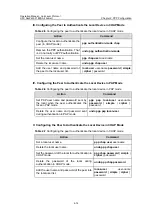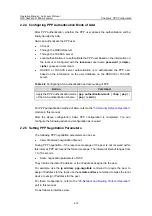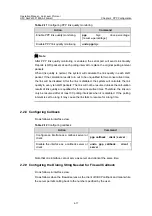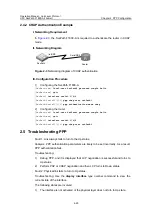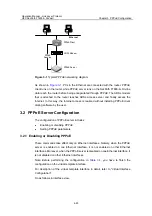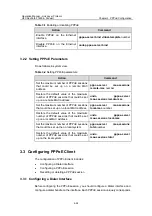
Operation Manual - Link Layer Protocol
H3C SecPath F1800-A Firewall
Chapter 3 PPPoE Configuration
4-26
z
Packet triggering mode
When the physical line is Up, the router will not initiate PPPoE call to create a PPPoE
session until data is to be transmitted. If the idle time of a PPPoE link exceeds the
user-defined value, the firewall will automatically terminate the PPPoE session.
3.3.3 Resetting or Deleting a PPPoE Session
You can use the
reset pppoe-client
command in user view, and the
undo
pppoe-client
command in Ethernet interface view.
Table 3-5
Resetting or deleting a PPPoE session
Action
Command
Reset a PPPoE session and
re-create it later.
reset pppoe-client
{
all
|
dial-bundle-number
number
}
Delete a PPPoE session and
re-create it no longer.
undo pppoe-client dial-bundle-number
number
The
reset pppoe-client
command differs from the
undo pppoe-client
command.
The former only temporarily terminates a PPPoE session, while the latter permanently
deletes a PPPoE session.
z
When a PPPoE session works in permanent on-line mode, if it is terminated by
the
reset pppoe-client
command, the router will automatically re-create a
PPPoE session later.
z
When a PPPoE session works in packet triggering mode, if it is terminated by the
reset pppoe-client
command, the router will re-create a PPPoE session only
upon data transmission.
z
No matter a PPPoE session works in permanent on-line mode or in packet
triggering mode, it will be deleted permanently by the
undo pppoe-client
command. If it is necessary to re-create a PPPoE session, the user must
configure it again.
3.4 Displaying and Debugging PPPoE
You can use the
display
command in any view to view the running state and thus
verify the effect of PPPoE.
You can use the
debugging pppoe-client
command in user view to debug PPPoE.
Table 3-6
Displaying and debugging PPPoE Client
Action
Command
View the status and statistics of the
PPPoE session.
display pppoe-server
session
{
all
|
packet
|
statistics
interface-type
interface-number
}



